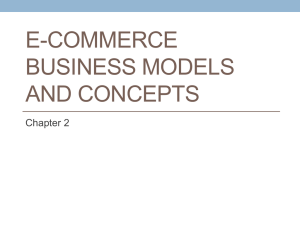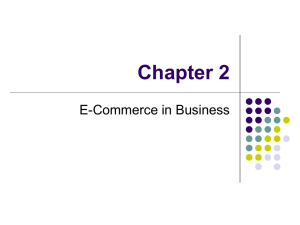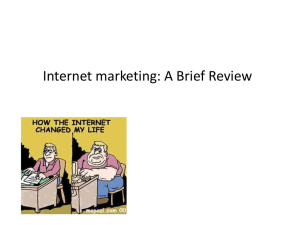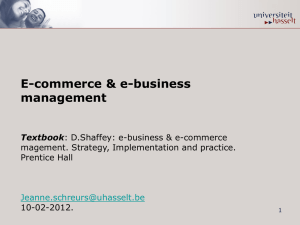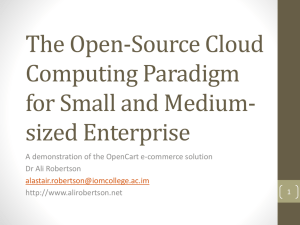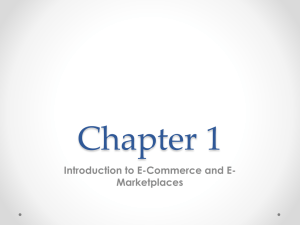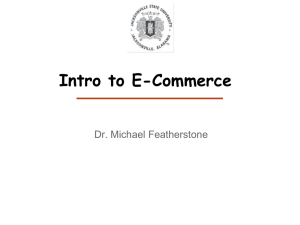ec business models
advertisement
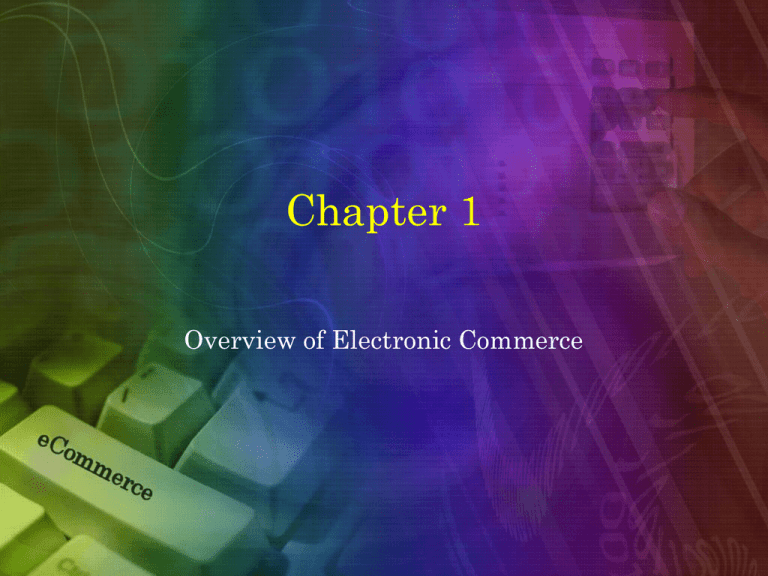
Chapter 1 Overview of Electronic Commerce Learning Objectives 1. 2. 3. 4. 5. Define electronic commerce (EC) and describe its various categories. Describe and discuss the content and framework of EC. Describe the major types of EC transactions. Describe the digital revolution as a driver of EC. Describe the business environment as a driver of EC. Describe some EC business models. 6. Describe the benefits of EC to organizations, consumers, and society. 7. Describe the limitations of EC. 8. Describe the contribution of EC to organizations responding to environmental pressures. 9. Describe online social and business networks. 10. Describe online social and business networks. Definitions and Concepts • electronic commerce (EC) The process of buying, selling, transferring, or exchanging products, services, or information via computer networks. • e-business A broader definition of EC that includes not just the buying and selling of goods and services, but also servicing customers, collaborating with business partners, and conducting electronic transactions within an organization. Definitions and Concepts • Pure versus Partial EC – EC Organizations • brick-and-mortar (old economy) organizations Old-economy organizations (corporations) that perform their primary business off-line, selling physical products by means of physical agents. • virtual (pure-play) organizations Organizations that conduct their business activities solely online. • click-and-mortar (click-and-brick) organizations Organizations that conduct some e-commerce activities, usually as an additional marketing channel. Definitions and Concepts 1.1 Definitions and Concepts • Internet Versus Non-internet EC – intranet An internal corporate or government network that uses Internet tools, such as Web browsers, and Internet protocols. – extranet A network that uses the Internet to link multiple intranets. Definitions and Concepts • electronic market (e-marketplace) An online marketplace where buyers and sellers meet to exchange goods, services, money, or information. • Interorganizational information systems (IOSs) Communications systems that allow routine transaction processing and information flow between two or more organizations. • intraorganizational information systems Communication systems that enable e-commerce activities to go on within individual organizations. The EC Framework, Classification, & Content The EC Framework, Classification, & Content • Classification By Nature Of Transactions Or Interactions – business-to-business (B2B) E-commerce model in which all of the participants are businesses or other organizations. – business-to-consumer (B2C) E-commerce model in which businesses sell to individual shoppers. – e-tailing Online retailing, usually B2C. – business-to-business-to-consumer (B2B2C) E-commerce model in which a business provides some product or service to a client business that maintains its own customers. The EC Framework, Classification, & Content – consumer-to-business (C2B) E-commerce model in which individuals use the Internet to sell products or services to organizations or individuals who seek sellers to bid on products or services they need. – mobile commerce (m-commerce) E-commerce transactions and activities conducted in a wireless environment. – location-based commerce (l-commerce) M-commerce transactions targeted to individuals in specific locations, at specific times. The EC Framework, Classification, & Content – intrabusiness EC E-commerce category that includes all internal organizational activities that involve the exchange of goods, services, or information among various units and individuals in an organization. – business-to-employees (B2E) E-commerce model in which an organization delivers services, information, or products to its individual employees. – collaborative commerce (c-commerce) E-commerce model in which individuals or groups communicate or collaborate online. The EC Framework, Classification, & Content – consumer-to-consumer (C2C) E-commerce model in which consumers sell directly to other consumers. – peer-to-peer Technology that enables networked peer computers to share data and processing with each other directly; can be used in C2C, B2B, and B2C e-commerce. – e-learning The online delivery of information for purposes of training or education. – e-government E-commerce model in which a government entity buys or provides goods, services, or information from or to businesses or individual citizens. The EC Framework, Classification, & Content – exchange A public electronic market with many buyers and sellers. – exchange-to-exchange (E2E) E-commerce model in which electronic exchanges formally connect to one another for the purpose of exchanging information. The EC Framework, Classification, & Content • The Interdisciplinary Nature Of EC – The Google Revolution – EC Failures – EC Successes The EC Framework, Classification, & Content • Web 2.0 The second-generation of Internet-based services that let people generate content, collaborate, and share information online in perceived new ways— such as social networking sites, wikis, communication tools, and folksonomies. The EC Framework, Classification, & Content Drivers: The Digital Revolution • digital economy An economy that is based on digital technologies, including digital communication networks, computers, software, and other related information technologies; also called the Internet economy, the new economy, or the Web economy. Drivers: The Digital Revolution • The digital revolution accelerates EC mainly by providing competitive advantage to organizations. • The digital revolution enables many innovations Drivers: The Business Environment • The Business Environment – The Business Environment Impact Model – Business Pressures and Opportunities – Organizational Response Strategies Drivers: The Business Environment EC BUSINESS MODELS • business model A method of doing business by which a company can generate revenue to sustain itself. EC BUSINESS MODELS • TYPICAL EC BUSINESS MODELS – Online direct marketing – Electronic tendering systems for procurement • tendering (bidding) system Model in which a buyer requests would-be sellers to submit bids; the lowest cost or highest value bidder wins. – name-your-own-price model Model in which a buyer sets the price he or she is willing to pay and invites sellers to supply the good or service at that price. EC BUSINESS MODELS – Find the best price • also known as a search engine model – affiliate marketing An arrangement whereby a marketing partner (a business, an organization, or even an individual) refers consumers to the selling company’s Web site. – viral marketing Word-of-mouth marketing in which customers promote a product or service to friends or others. EC BUSINESS MODELS – group purchasing Quantity (aggregated) purchasing that enables groups of purchasers to obtain a discount price on the products purchased. • SMEs Small-to-medium enterprises. • e-co-ops Another name for online group purchasing organizations. EC BUSINESS MODELS – Online auctions – Product customization and service personalization • customization Creation of a product or service according to the buyer’s specifications. • personalization The creation of a service or information according to specific customer specifications. EC BUSINESS MODELS – – – – – – – – Electronic marketplaces and exchanges Information brokers (infomediaries) Bartering Value-chain integrators Value-chain service providers Supply chain improvers Social networks, communities, and blogging Negotiation EC BUSINESS MODELS • virtual world A user-defined world in which people can interact, play, and do business. The most publicized virtual world is Second Life. Benefits and Limitations of EC • THE BENEFITS OF EC – – – – Benefits to Organizations Benefits to Consumers Benefits to Society Facilitating Problem Solving Benefits and Limitations of EC • THE LIMITATIONS AND BARRIERS OF EC – Technological Limitations – Nontechnological Limitations • SOCIAL AND BUSINESS NETWORKS – social networks Web sites that connect people with specified interests by providing free services such as photo presentation, e-mail, blogging, and so on. – Business-Oriented Networks – Revenue Models of Social and Business Networks The Digital Enterprise • digital enterprise A new business model that uses IT in a fundamental way to accomplish one or more of three basic objectives: reach and engage customers more effectively, boost employee productivity, and improve operating efficiency. It uses converged communication and computing technology in a way that improves business processes. The Digital Enterprise • corporate portal A major gateway through which employees, business partners, and the public can enter a corporate Web site. Managerial Issues 1. Is it real? 2. Why is B2B e-commerce so attractive? 3. There are so many EC failures—how can one avoid them? 4. How can we exploit social/business networking? 5. What should be my company’s strategy toward EC? 6. What are the top challenges of EC? Summary 1. Definition of EC and description of its various categories. 2. The content and framework of EC. 3. The major types of EC transactions. 4. The role of the digital revolution. 5. The role of the business environment as an EC driver. Summary 6. The major EC business models. 7. Benefits of EC to organizations, consumers, and society. 8. Barriers to EC. 9. Social and business online networks.



